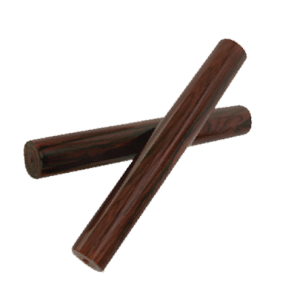Lesson 1: Learning “El Manisero”
Aim: What is the clave rhythm and where can we find it in “El Manisero?”
Summary: Students learn to clap a basic clave pattern and sing the chorus of “El Manisero.”
Materials: Musical Explorers CD or online audio
Standards: GA: ESGMK-2.CR.1, ESGMK-2.CR.2, ESGMK-2.CR.3, ESGMK-2.PR.1, ESGMK-2.RE.1, ESGMK-2.RE.3, ESGMK-2.CN.2
SC: GM.CR.NL-AH.1, GM.CR.NL-AH.2, GM.PR.NL-AH.3, GM.RE.NL-AH.6, GM.CN.NL-AH.8
Vocabulary: clave rhythm, claves, coro, salsa
Summary: Students learn to clap a basic clave pattern and sing the chorus of “El Manisero.”
Materials: Musical Explorers CD or online audio
Standards: GA: ESGMK-2.CR.1, ESGMK-2.CR.2, ESGMK-2.CR.3, ESGMK-2.PR.1, ESGMK-2.RE.1, ESGMK-2.RE.3, ESGMK-2.CN.2
SC: GM.CR.NL-AH.1, GM.CR.NL-AH.2, GM.PR.NL-AH.3, GM.RE.NL-AH.6, GM.CN.NL-AH.8
Vocabulary: clave rhythm, claves, coro, salsa
Sing “El Manisero”
- Listen to “El Manisero,” Track 19.
- “El Manisero” is Spanish for “the peanut vendor”—”maní” means “peanuts.”
- “El Manisero” is a famous song from Cuba. It is based on the cry of a street vendor selling peanuts (“Maní, maní, maní”).
- Learn and sing the first coro (Spanish for “chorus”), Track 20 and Track 21, and clap on the first and third beats.
- “Que rico es el maní?” means “How delicious are peanuts?” in English.

- Learn and sing the second coro, Track 22 and Track 23, and clap on the first and third beats.
- “Ya se va manisero, ya se va!” means “There goes the peanut vendor, there he goes!” in English.

- Listen to “El Manisero” again, Track 19, and sing along to each coro.
Maintain the steady beat by either patting or walking on the first and third beats.
Explore the Clave Rhythm
- Listen to Gino play the claves and say “bistec chuleta” in clave, and repeat along with Gino on Track 24.
- “Bistec chuleta” is Spanish for “steak” and “pork chops”—two of Gino’s favorite foods! They also use these words to remember how to clap the clave pattern.
- What words or combination of words can you think of that also sound like the clave pattern? (e.g., “Hello! How are you?” or “Let’s go to the park!”)
- Use SG32 to write a phrase using the clave rhythm. Perform the new phrases you create with Track 25.
- Listen to “El Manisero” again, Track 19, and clap along to the clave pattern.
- Divide students into two groups and ask one group to tap the steady beat while the other group claps the clave rhythm.

“Clave” (pronounced KLAH-vey) means “key” or “keystone” and is an Afro-Cuban rhythmic pattern that holds all salsa music together. This pattern is played on a percussion instrument called the claves (pronounced KLAH-veys) and contains five beats, or strokes. “El Manisero” and “Vamanos pa’l Monte” are both performed using the 2/3 son clave pattern. This can be remembered by repeating the 2/3 syllable phrase “Bis-tec, Chu-le-ta.”

Creative Extension: Learn the Basic Sidestep in 2/3 Clave
- Starting on your right foot, step to your right.
- Bring your left foot together with your right foot.
- Step out again with your right foot.
- Touch your left heel in front of you.
- Repeat this pattern on the left side, and add circular arm motions with the music.
Musical Word Wall
Add the words clave rhythm, claves, coro, and salsa to the Musical Word Wall.
PDF Downloads
SG32 ↓ Download File
Musical Explorers Audio Tracks
